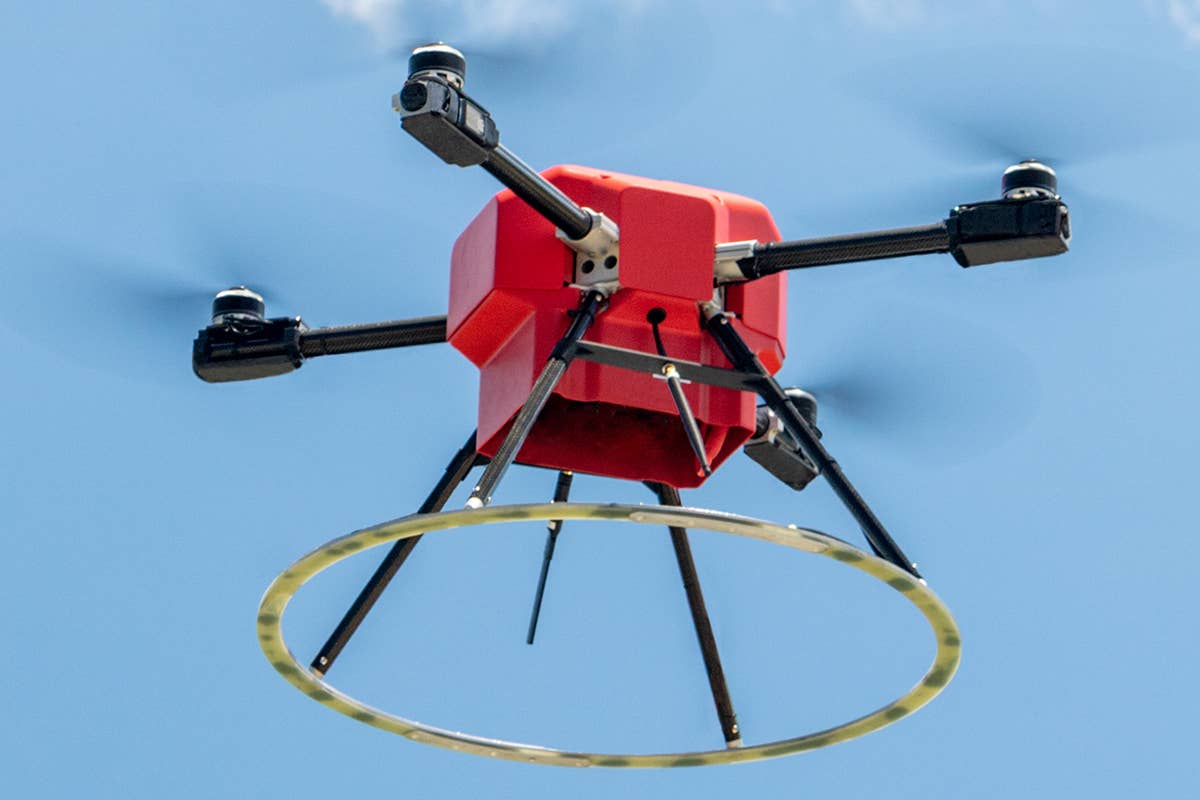Autonomous Drones Could Change Aviation Landscape
Massachusetts company acquired FAA approval to fly its ‘Scout’ drone with no human interface last year.

The autonomous system allows a user to monitor a single drone, or multiple drones, at distances up to 1,000 miles. [Photo: American Robotics]
In spring 2021, the FAA gave American Robotics (NASDAQ: ONDS), a Massachusetts-based company, permission to fly its industrial commercial “Scout” drone autonomously, requiring no human pilot interface or line of sight observation from the ground.
This was the first such approval from the FAA and forms one indication of how the future of industrial work might look without pilots. The operation would foreseeably allow railroad, pipeline, farming, and mining companies to monitor their assets remotely, with no compromise to human operator safety.
Sold as a Robot-as-a-Service platform as a monthly subscription, the Scout’s autonomous system would allow a user to monitor a single drone, or multiple drones, at distances up to 1,000 miles.
It’s beginning to happen.
Chevron Signs On
In late January, Chevron (NYSE: CVX) became the second Fortune 100 customer in the oil and gas space to partner with American Robotics. In a statement, Reese Mozer, CEO and co-founder of American Robotics, called his efforts “game-changing” and explained how the new drone platform would empower customers.
"...drone use is about collecting and analyzing data continuously, so full autonomy is required to unlock the full potential."
Reese Mozer, CEO and co-founder, American Robotics
“Before our FAA approvals, asset managers that used drones to monitor their oil and gas fields needed to employ pilots and visual observers to fly the systems manually, and then manually convert the data into actionable insights,” Mozer explained.
“With Scout System, we are providing the oil and gas industry with a dramatically more efficient and effective way to manage, monitor, and inspect their assets. Analytics that were previously unattainable due to high costs of operation are now available through the Scout System, allowing users to make informed decisions in real-time that will drive their business forward.”
Everything is automated, from landing to charging to data processing. Once installed, Scout systems will run missions autonomously, collecting, processing, and analyzing data. The drone lives in a weatherproof charging and data processing station called ScoutBase, and once it is installed at a location, customers can interact with the system via an app.
While it is easy to think this will be disruptive to the pilot workforce, as it will cost customers a fraction of the cost to use compared to hiring a flight department, it allows customers to achieve things they couldn’t before.
Not Removing Pilots, but Improving Safety and Efficiency
For customers with millions of acres of assets that must be monitored regularly for hazards such like leaks, emissions, or secondary structure, it becomes impractical, time-consuming, labor-intensive, and at times unsafe for pilots. In the agriculture sector, a CDC report that tracked work-related pilot fatalities between 1992 and 2001 recorded close to 150 pilot deaths, 12 percent of all combined pilot fatalities for the same period.
In 2014, the NTSB issued a special report investigating the cause behind 78 crop-dusting airplane accidents the previous year.
This is where drones offer an out. American Robotics’ systems will conduct up to 20 autonomous missions per day without having a pilot or visual observer on the ground.
The company says that adopting this technology in the agricultural sector—for one—should allow for automated inspections, regular site monitoring, and enhanced safety for employees, all at a lower cost with increased accuracy.
“Overcoming the human cost associated with the commercial drone use has been the biggest hindrance to the drone industry unlocking its full potential or achieving scale,” Mozer told FLYING.
“In the industrial market,” he explained, “drone use is about collecting and analyzing data continuously, so full autonomy is required to unlock the full potential.”
The recent Chevron deal gives insight into an immediate solution that American Robotics offers. For instance, oil and gas companies are facing substantial regulatory reform to reduce and eliminate emissions. The U.S. Environmental Protection Agency’s (EPA) new Clean Air Act contains federal law requiring companies to reduce methane emissions by 30 percent by 2030. Companies can monitor their assets with American Robotics’ Scout to ensure compliance. This shapes up to be a good problem for American Robotics to solve. One study from ABI Research indicates that the oil and gas industry is projected to spend $15 billion to improve its digital capabilities by 2030.
What About Collision Avoidance?
While that improvement is welcomed, the question remains about ensuring safety as autonomous drones move forward into reality. Mozer said that part of gaining the FAA approval proved that they could maintain or mitigate scenarios that could cause collisions.
“Our system implements a layered and redundant set of both technical and operational risk mitigations, including ground-based aircraft detection sensors that can detect aircraft up to 10 kilometers away, and ADS-B,” Mozer said.
“We also have strict three-dimensional geofencing—each drone system is constrained to only operate within a two-mile radius around the base station, under 400 feet altitude. Within that bubble, our system of aircraft detection sensors assures that our drone will always maintain well clear any other aircraft.”
For 2022, the company says its biggest priority is expanding its delivery capabilities and building out the ground support staff to set up stations. They also plan to expand into about 20 other markets.
“We estimate there to be over 10 million applicable assets around the world that these systems will eventually monitor,” he says.

Subscribe to Our Newsletter
Get the latest FLYING stories delivered directly to your inbox






